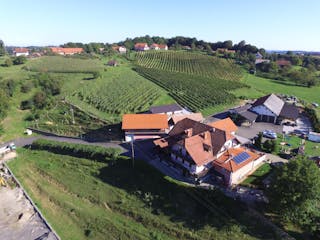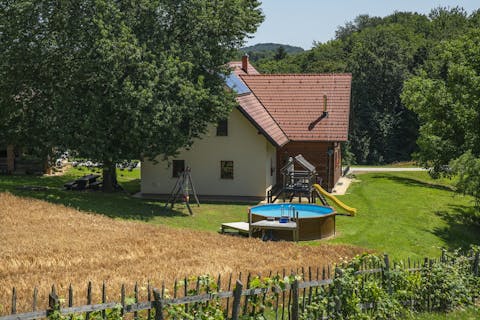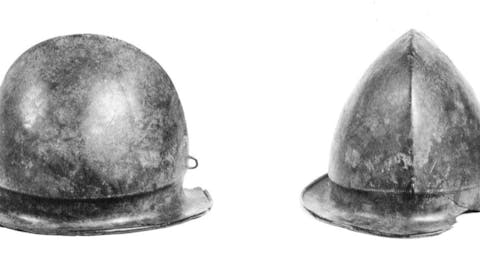
BENEDIKT MUNICIPALITY
Burial Mounds of Benedikt
The Benedikt area, a friendly land of rolling hills, charming valleys, and the watershed of the Ročica and Drvanja streams in the heart of the Slovenske gorice, was already in the past a center of vibrant historical and cultural activity. From this region come the largest burial mound cemeteries in Slovenia (Trotkova, Trstenik, Benedikt, Spodnja Ročica, and Ločki Vrh), Roman settlement remains (Drvanja, Ihova, Trotkova, and Obrat), and the world-famous discovery of 26 Bronze Age Negova helmets from Ženjak.
The helmets still stir the imagination of experts at home and abroad with their collective burial and above all with the inscriptions engraved on them. They were discovered in 1811 on his estate in Ženjak by Jurij Slaček. From there, they traveled to Maribor to the gunsmith Denzl, then to the Joanneum Museum in Graz, and finally to Vienna to the “Cabinet of Numismatics and Antiquities.” As a result, of the 26 helmets found, only one has been preserved in the National Museum in Ljubljana, as a reminder of one of the most important archaeological discoveries in Slovenia. The bronze Negova helmets, dating to between 450–350 BC, the transitional period from the Hallstatt to the La Tène culture, bear not only traces of sword blows but also inscriptions. The most intriguing for scholars is the “Germanic” inscription HARIGASTI TEIVA III IL, which is interpreted as: Harigast, a member of the Germanic tribe, dedicates or offers the helmets to the god Teiva—a votive dedication. Despite numerous attempts to reassign the helmets to other historical periods, especially the Roman era, such theories have proven untenable and unconvincing. Thus, the Negova helmets can only be understood as belonging to the Iron Age.
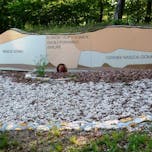
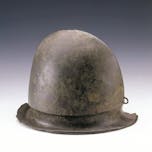
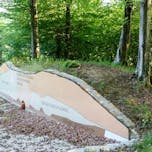
The first reports of research in the Benedikt area were documented as early as 1900, when parish priest F. Zmazek mentioned the antiquities excavator, chaplain F. Vrbnjak, and chaplain J. Mund, who in 1903 donated the excavated objects from the burial mounds to the Museum of the Historical Society of Maribor. However, systematic research and the publication of professional reports in print only began after the Second World War, when in 1957 Stanko Pahič, curator and archaeologist of the Maribor Regional Museum, together with teacher Vlado Lorber from Cerkvenjak, embarked on a topographical survey of archaeological monuments in Slovenske gorice. In the following years, students of the Department of Archaeology of the University of Ljubljana also participated. All these reports and academic publications later served as the foundation for the publication of the Archaeological Map of Slovenia in 1975.
In more recent times, in 2002 and 2003, research began on Mound 2 in Benedikt with the aim of determining the chronological context of the burial mound cemetery. Excavations began with the participation of the archaeological group at the Youth Research Camp “Ščavnica 2002” and were completed in 2003 through the efforts of Mayor Milan Gumzar and with the support of the Municipality of Benedikt. The findings revealed that the mound dates to the Roman period, specifically the 1st and the first half of the 2nd century AD, and that a woman engaged in weaving domestic linen was buried there. Moreover, it was established that the mound lies on the occupational surface of a prehistoric settlement dating back to the Early Iron Age, between 750 and 650 BC. Importantly, the arrangement of the burial mound cemetery and the installation of explanatory panels at Mound 2 in Benedikt serve to present this archaeological monument in its natural setting to the broader public. By including archaeological monuments in educational and pedagogical programs, the locality can take pride in its heritage and inspire the younger generations to learn about it and preserve it for the future. After all, only a nation that knows its past and lives with it has no reason to fear the future.
Text from the Anthology of the Municipality of Benedikt
Author: Ivan Tušek
How to Reach Burial Mounds of Benedikt
Recommended in Benedikt
Church St. Benedikt
Church of the Three kings
Čolnikova Vine
Sacristan's house
Slatin springs

